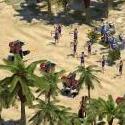Leaderboard
Popular Content
Showing content with the highest reputation on 2017-08-21 in all areas
-
3 points
-
1 point
-
Which package management system remember that we support three separate platforms so three systems would be needed and who would by necessity code them they do not exist for Windows or OSX those binaries are only for Windows as most of our users share that OS and very few have the knowledge to build from source these users are also mod developers that need access to the latest build.This has been proposed several times and the consensus has been it's to much work for minimal benefit we already have have a Git mirror though it does trail the main SVN repository by a few commits. Enjoy the Choice1 point
-
Part of the problem migrating is that there's a bunch of stuff in the repository that shouldn't be in a code repository at all. Plus We have all of the "default" 0AD mod/resources in the same repo as all engine code. These are really orthogonal, and belong in separate repositories. We have many dependencies in the repository. These do not belong in a code repository, but some sort of binary repository/dependency management system (eg, Nuget in the C# world, or maven for Java). C++, however, has not traditionally used one of these systems. The final, built binaries, are in the repository. Ideally, we should probably be doing something like: Git repository for main engine code (+ some small default resources). This can be self-hosted, or use an existing provider and backup a copy every day. Dependency management repository for code artifacts. There are some out there for C++, although we will likely have to host at least some of our own. Git repository for the "default" 0AD mod code Repository/ies for art source files. Note that the goal would be to have no "built" items in a live repository, instead: Dependency management repository for built art files. This also gets used by: Binary repository that combines art files and mod + engine code into the finished product. .... which would be quite some work to set up. I think the best first step, though, would be to start getting dependencies out of the main repository and into a package management system.1 point
-
@s0600204 A pleasure to help, and a little compensation for your hard work on mods1 point
-
Committed: https://code.wildfiregames.com/rP20020 Thank you @stanislas69 for the patch, and apologies it took this long to review and commit it!1 point
-
And the ManLab skin material is quite complex it uses subsurface scattering which the game rendering does not support and then there are the rigging issues for animations as well as adding clothes changing workflow on any project is always very complex and tool chains can be idiosyncratic to each creator. Enjoy the Choice1 point
-
1 point
-
After Hannibal explained it to me again, I finally understood the difference you meant xD "will have won" means that the victory could occur before the timer runs out too. I've changed the wonder victory message accordingly in rP20017 and added the period as well.1 point
-
Considering that he hasn't logged in to the forums for four years, it's unlikely that you will get a reply1 point
-
1 point
-
I was not aware of the max population in a tooltip or the objectives. The objectives could be shown off in a tutorial and the max pop could also be mentioned in a tutorial. You are probably right that many may forget or ignore it. The AI handles the lower populations fine, but is dramatically easier to beat. This is because the AI cannot overwhelm the enemy with large forces as easily because some have to be reserved for civil duties. This makes skirmishes more defensive which favors newer human players who are not as skilled in the game. (It makes turtling much easier.) Once an adequate defense has been built, a large army can be constructed. The human player can opt to build a wonder and/or make all gatherers into fighters for a significant population advantage over the AI. This works well against the AI because the it will generally not do either of those.1 point
-
This had been reported by a number of users on trac actually. @gameboy this also happens with alpha 22, right?1 point
-
The objectives dialog shows the maximum population set in the match setup. Indeed that excludes the civ and wonder bonus. The exact number is seen in the tooltip of the population counter. But that doesn't help if anyone knows about it. In fact most people also don't know that there is an obejctives dialog. So I don't really know what to do. Even if we would show a message box on gamestart, people would click on Ok without reading it. xd Is it really a necessity? By default, we play 150 pop without wonders in multiplayer 4v4s for performance reasons. It really depends on how the units are used, which is something we can expect from players, but how does the AI deal with 200 pop? I can't imagine that it only functions reliably with 300 pop. @mimo has the most experimental data I guess. Index: binaries/data/mods/public/simulation/data/settings/population_capacities.json =================================================================== --- binaries/data/mods/public/simulation/data/settings/population_capacities.json (revision 20009) +++ binaries/data/mods/public/simulation/data/settings/population_capacities.json (working copy) @@ -1,4 +1,4 @@ { "PopulationCapacities": [50, 100, 150, 200, 250, 300, 10000], - "Default": 300 + "Default": 200 }1 point
-
For those unfamiliar with Hyrule or the Total War version of my game, here's a list of the factions that I'll be porting over and a brief summary of their armies and abilities:1 point
-
From my personal player pov, 200 would be ok for me and 300 have always appeared like pure spam games. (Also often players just the 8 players without reducing the population limit, which totally doesn't work performance wise if everyone reaches the limit.)1 point
-
1 point
-
I think the general problem is that it seems impossible to have the same unit weak vs women in village phase but also decent against champs in city phase. Currently citizen-soldiers get +20% hp in town and +10% hp in city. I think we should we should make that more like the veteran upgrade, i.e. have phases give increases in health, armor, attack, accuracy, range, vision, and speed. If citizen-soldiers are weaker, then women and towers are stronger. (We could even make the cavalry bonuses bigger than the infantry ones, if that was necessary to further weaken early raiding.) Another idea is ballistics, to make it a technology to have ranged units aim at moving targets just as accurately as stationary ones. Since fleeing women are moving while hunted animals are largely stationary, this would allow skirm cavalry to be effective hunters while at the same time being ineffective raiders (unless the opponent's not paying attention). It would also making fighting more micro-intensive. This would need testing and maybe some tweaks to projectile speeds. I agree with the need to distinguish sword and spear cavalry, for gameplay reasons. Although I think others have said that actually sword cav should be the counter unit?1 point
-
The Spartans revered music and poetry as much as the Athenians did. Why? Because learning these things sharpened one's mind for war, of course. So, Apollo's special effect could be Tyrtean Paeans, which help their hoplites move faster.1 point
-
Team bonuses — Civilization bonuses All bonuses and penalties from the default distribution have been removed. Carthage: Market technologies −30% resource costs and research time; Markets −50% wood cost; City Walls +25% stone cost, −25% wood cost, +20% build time, +20% health; Traders and Merchant Ships −15% training time. Gauls: House technologies −40% resource costs and research time; Centres 0 stone cost, +150% wood cost, −20% build time, −20% health, −10% territory influence; Economic Structures −15% build time, −15% health; Fortresses −50% stone cost, +100% wood cost; Military Structures −20% build time, −20% health; City Walls −10% build time, −10% health; Temples 0 stone cost, +200% wood cost, −40% build time, −40% health; Healers +2 armour levels; Melee Cavalry −15% training time. Kushites: Temple technologies −10% resource costs and research time; Economic Structures −70% wood cost, +100% build time. Macedon: Forge technologies −10% resource costs and research time; Military Structures −10% build time; Siege Engines −15% construction time. Mauryas: Palace technologies −10% resource costs and research time; Centres 0 stone cost, +200% wood cost, +5 population bonus, +10 garrison capacity; Economic Structures −10% wood cost, −10% build time, −10% health; City Walls 0 stone cost, +200% wood cost, −25% build time, −25% health; Temples 0 stone cost, +300% wood cost, −20% build time, −20% health; Elephants −15% training time; Healers −50% silver cost. Ptolemies: Naval technologies −25% resource costs and research time; Economic Structures −70% wood cost, +100% build time; Healers −20% healing time. Rome: Arsenal technologies −50% resource costs and research time; Wooden Walls −10% build time; City Walls +10% stone cost, +10% wood cost, +10% build time, +10% health. Catapults +25% wood cost, +20% health, +25% ranged attack crush damage. Seleucids: Stable technologies −20% resource costs and research time; Starting Centre +30% resource costs, +30% build time, +5 population bonus, +10 garrison capacity, +30% health, +30% capture points, +11% territory influence. Class bonuses Champion: +200% silver cost, +100% training time, +50% health, +2.0 armour levels, +100% capture attack strength, and +100% melee and ranged attack damage. Veteran: +50% silver cost, +50% training time, +20% health, +1.0 armour levels, +50% capture attack strength, and +50% melee and ranged attack damage. Mercenary: +100% silver cost, 0 other resource costs, −50% training time, +10% health, +25% capture attack strength, and +15% melee and ranged attack damage. Cataphract: +20% silver cost, +2 armour levels, and −5% movement speed. Fanatic: −4 armour levels, +15% melee attack damage, and +30% movement speed. Indian Elephant (Mauryas, Seleucids): +10% food and silver costs, training time, health, and melee attack damage. North African Elephant (Carthaginians, Kushites, Ptolemies): −10% food and silver costs, training time, health, and melee attack damage.1 point
-
At a guess: when the foundation is placed, 0ad chooses a variant from each group based on their frequency, and the end result is a combination of these choices (the mesh is chosen from the first group, texture from the third, and so on). If there is no frequency defined for a variant, then that variant won't ever be chosen. When the units in-game reach the foundation and start building, 0ad switches to the specifically named "scaffold" variant in all the groups that have a variant by that name (if a given group doesn't have a variant by that name, then the output from that group doesn't change). In the unedited 6x6 foundation file wgoyc pasted above, we can see that the second group has both both an "Idle" and a "scaffold" variant. The first has the eyecandy bricks and piles of wood etc, but the latter does not. So when 0ad switches to the "scaffold" variant, all the eyecandy disappears. The edited 6x6 file works because the eyecandy is in a different group which happens to not have a variant with the name "scaffold" and so is not affected by the switch. Essentially, his suggested change based on the 2x2 actor is correct. So just make a patch based on that, and make similar changes to the 8x8 foundation actor.1 point







.thumb.png.ce58cea22940c255f5b0a735d5abee36.png)





